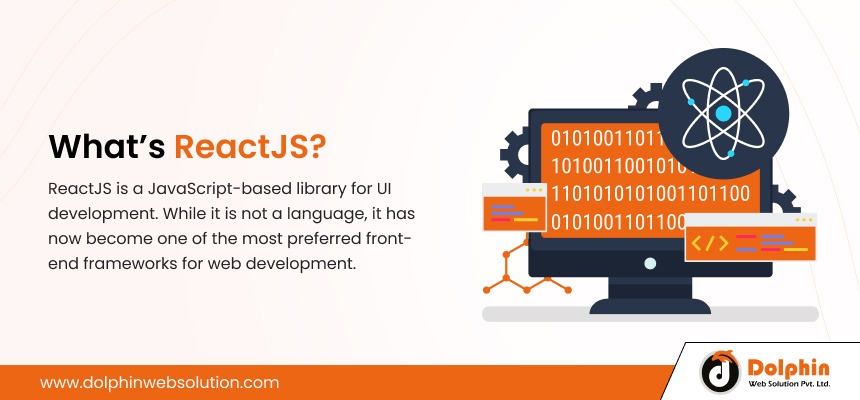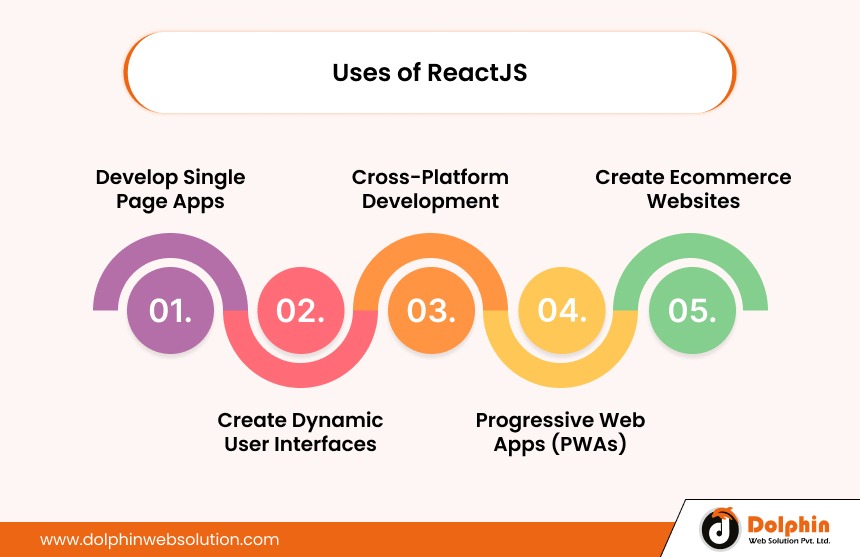What is ReactJS? All You Need to Know About ReactJS in 5 Minutes

Table of Contents
Summary :
React is one of the top JavaScript libraries for creating web and mobile app interfaces. Thanks to React’s versatility and flexibility, it has become one of the most used JavaScript libraries in the world. Top websites like Canva, Business Insider, etc., are developed using ReactJS. Get a quick overview of ReactJS in this blog post.
Introduction
Choosing the right framework for building web and mobile interfaces can be challenging.
You must consider a variety of elements to find the most suitable library for your project. Due to React’s extensive capabilities, features, and ease of development, many businesses use ReactJS for interface development. However, many app development agencies and companies are still wary of using it.
That’s why in this blog post, we quickly look at ReactJS, its use, advantages, features, and pros and cons.
Let’s start.
What’s ReactJS?

ReactJS is a JavaScript-based library for UI development. While it is not a language, it has now become one of the most preferred front-end frameworks for web development. Beyond just UI development, React also provides developers with diverse extensions, such as React Native, Flux, etc., for comprehensive application architectural support.
What are the Uses of ReactJS?
ReactJS has grown in popularity over the years due to its usability and extensive applications.

Let’s check a few of the uses of ReactJS here.
1. Develop Single Page Apps
ReactJS is perfect for SPAs, offering smooth navigation without reloading the entire page. It boosts the performance of the site as it has the DOM handling updates.
The frameworks also guarantee the following with SPAs.
- Fast user interaction
- Efficient resource loading
- Dynamic content without delays
2. Create Dynamic User Interfaces
React excels at building interactive, real-time UIs. Whether it’s a live chat app or a data dashboard, React ensures quick, responsive changes. It allows you to create complex interfaces that instantly respond to user input.
This makes ReactJS an obvious choice for dynamic applications.
3. Cross-Platform Development
React Native helps developers build iOS and Android apps with a shared codebase. The apps can perform like native ones. This approach cuts down development time, making it faster and more cost-effective.
These cross-platform apps also ensure the same experience as native apps.
4. Progressive Web Apps (PWAs)
React is ideal for building PWAs, which combine the best of web and mobile apps. Thanks to React, PWAs work offline, load fast, and give users an app-like feel.
PWAs also help businesses reach customers without an expensive mobile app.
5. Create Ecommerce Websites
ReactJS is suitable for creating ecommerce stores as it can handle dynamic content. Apps developed with ReactJS are also scalable.
Here are the key benefits of using ReactJS to create e-commerce sites.
- Real-time inventory updates
- Fast loading times to improve UX
- Integration with payment systems for smooth checkout
Pros and Cons of ReactJs
ReactJS is one of the best frameworks for front-end development for a variety of reasons. Let’s discuss the major pros and cons of ReactJS.
Pros of ReactJS

Here are the top pros of ReactJS.
1. Ease Of Use
ReactJS is easy to learn and use, and those already familiar with JavaScript will find it even easier. Tutorials, documentation, training tools, etc., help with further learning.
2. Fast Rendering
Thanks to the virtual DOM, ReactJS enables faster rendering. React compares the virtual DOM and real DOM for differences and updates the real DOM as needed.
3. Modular Architecture
ReactJS uses a modular architecture. This allows React developers to modernize components without affecting other elements, resulting in faster development times.
4. Cross-Platform Code Reuse
Developers use ReactJS to create a cross-platform codebase. This component logic can work on different platforms, like iOS, Android, and the web.
5. SEO Friendly
ReactJS apps can run on the server. This makes it easy for search engines to crawl and navigate them easily, helping websites improve their SEO performance.
6. Server-Side Rendering
Developers can use React to achieve server-side rendering. This allows a page to be faster when interacting with the users.
Cons of ReactJS

Let’s check out a few cons of ReactJS.
1. Lack of Adequate Documentation
As ReactJS technologies change faster, the community finds it difficult to document updates, making the framework a bit challenging to use.
2. Too Much Focus on UI Development
ReactJS is a tool for developing user interfaces for apps and web solutions. Hence, developers may need to rely on other tools and frameworks to build the rest of the app.
3. Challenges with JSX
JSX is an extension that makes code readable and clean. Although it is aimed to help developers work better with ReactJS, many developers find JSX code too complex.
4. Overwhelming Fast Updates
ReactJS changes and evolves too fast for its own good. This often overwhelms the developers as the framework changes before they learn the existing version.
Features of ReactJS
React comes packed with a variety of features. Each feature makes the framework more efficient, usable, and developer friendly. These features also work together to make apps and websites developed with React faster and better performing.

Here are some of the vital features that make ReactJS highly beloved
1. Components
React JS is based on the concept of reusable codes called components. Each component represents one part of a UI. They help break down complex UIs into small, manageable bits. Which makes maintaining and scaling code easier.
2. JSX
JSX is a syntax extension for JavaScript. It allows you to write HTML-like code within JavaScript. Developers also use JSX to create and modify the UI structure directly from their JS code.
3. Virtual DOM
A virtual DOM is a lightweight in-memory depiction of the actual DOM. React utilizes a virtual DOM to reduce direct manipulations on the real DOM. When the state of any component changes, React compares the new and old components to update the virtual DOM based on the changes. This leads to efficient and faster UI updates.
4. State and Props
Components in ReactJS have their own internal states. A state is an object holding the values of various properties in React that change over time. Often, the state is managed within a React component. When any change occurs to the state, the component re-renders. Props are immutable elements that get passed to child components from parent components.
5. One-way Data Flow
React supports data flow in one direction. This means that parent components send data via props to child components as needed. The one-way data flow makes debugging and reasoning the app easier.
How to Find the Right ReactJS Development Company?
Once you have decided to go with ReactJS for an app or website development project, the next most important part is to find the right ReactJS development company.

Here are a few strategies to follow to research and finalize the most suitable agency for your ReactJS app and website development project.
1. Define Your Project Needs and Objectives
The first step is to define your project goals. What do you want to achieve? Who are you trying to serve? What’s your budget?
Identifying your goals will help you filter out companies that aren’t the right fit.
And you will also be able to move in the right direction.
2. Look for Expertise and Experience in ReactJS
Choose a company with proven ReactJS experience. Look through their portfolio to see if they’ve worked on similar projects. If you have already made a list of potential clients, interact with their teams to figure out this.
3. Check Client Reviews and Testimonials
Client feedback provides valuable insight into a company’s performance. Platforms like Clutch, GoodFirms, Upwork, etc., can give you an idea of their reputation. Also, ask the potential agency to share contact details of previous clients.
4. Check Collaboration and Communication
Good communication is critical to the success of any project. You can set up an initial consultation to assess how well they understand your needs. Ensure they can also work with preferred communication and collaboration tools.
5. Check the Cost Of Development
This is another crucial element to consider. Understand the pricing style of the ReactJS development company you want to hire. The pricing needs to be flexible and upfront with the cost.
Also, get an idea of taxes, other charges, etc., that the cost might include. This will help avoid confusion later.
Conclusion
ReactJS is extremely useful to develop top-notch UI for apps and web solutions. Being a developer-friendly JS framework, it also ensures faster development projects.
However, you need to work with a reliable React development agency to get the desired results. And if you are looking to hire ReactJS developers, Dolphin Web Solution is the best choice.
With years of experience, a team of ReactJS experts, and unique app development strategies, Dolphin Web Solution helps you meet all your project goals.
Get a free ReactJS project consultation from our team now.

Hello!
Click one of our contacts below to chat on WhatsApp

